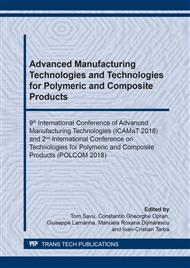[1]
J. D. Birchall, Cement in the context of new materials for an energy- expensive future, Philos. Trans. R. Soc. London, A310 31 (1983).
Google Scholar
[2]
P. P. Russel, MS thesis, University of Illinois at Urbana Champaign, (1991).
Google Scholar
[3]
A. D'Amore and L. Grassia, Toughening the Macro Defect Free (MDF) cements, AIP Conference Proceedings, 1255, 402 (2010).
DOI: 10.1063/1.3455650
Google Scholar
[4]
G. Lamanna, F. Caputo, L. Grassia, A. D'Amore, A. Soprano, Numerical simulation of a stretch bending process Key Engineering Materials, 417-418, 637-640, (2010).
DOI: 10.4028/www.scientific.net/kem.417-418.637
Google Scholar
[5]
L. Grassia, A. D'Amore, Modeling the residual stresses in reactive resins-based materials: A case study of photo-sensitive composites for dental applications, AIP Conference Proceedings, 1255, 408-410, (2010).
DOI: 10.1063/1.3455652
Google Scholar
[6]
L. Grassia, A. D'Amore, Modeling the flexural fatigue behavior of glass-fiber-reinforced thermoplastic matrices Mechanics of Time-Dependent Materials, 17(1), 1-13, (2013).
DOI: 10.1007/s11043-012-9192-y
Google Scholar
[7]
A. D'Amore, F. Caputo, L. Grassia, M. Zarrelli, Numerical evaluation of structural relaxation-induced stresses in amorphous polymers, Composites Part A-Applied science and manufacturing S, 37, 556-64, (2006).
DOI: 10.1016/j.compositesa.2005.05.011
Google Scholar
[8]
L. Grassia, A. D'Amore, Residual stresses in amorphous polymers, Macromolecular Symposia, 228, 1-15 (2005).
Google Scholar
[9]
M. Zarrelli, IK. Partridge, A. D'Amore, Warpage induced in bi-material specimens: Coefficient of thermal expansion, chemical shrinkage and viscoelastic modulus evolution during cure, Composite Part A-Applied science and manufacturing S, 37, 565-70 (2006).
DOI: 10.1016/j.compositesa.2005.05.012
Google Scholar
[10]
Y. Yang, A. D'Amore, Y. Di, L. Nicolais, B. Li, Journal Applied Polymer Science, 59, 1159- 66 (1996).
Google Scholar
[11]
A. D'Amore, G. Caprino, L. Nicolais, G Marino, Long-term behaviour of PEI and PEI-based composites subjected to physical aging, Composite Science and Technology, 59, 1993-2003, (1999).
DOI: 10.1016/s0266-3538(99)00058-5
Google Scholar
[12]
A. D'Amore, G. Caprino, P. Stupak, J Zhou, L. Nicolais, Effect of stress ratio on the flexural fatigue behaviour of continuous strand mat reinforced plasticsScience and Engineering Composite Materials, 5, 1-8, (1996).
DOI: 10.1515/secm.1996.5.1.1
Google Scholar
[13]
M. Drabik, SC. Mojumdar, Prospects of novel macro-defect-free cements for the new millennium R.C.T. Slade, Ceramics – Silikaty, 46 (2), 68–73 (2001).
Google Scholar
[14]
M. Rosa, L. Grassia, A. D'Amore, G. D'Escamard, Enthalpy Relaxation of Polystyrene at Different Molecular Weight Using Fast Calorimetry, Procedia Engineering, 167, 265-269, (2016).
DOI: 10.1016/j.proeng.2016.11.696
Google Scholar
[15]
L. Grassia, A. D'Amore, S.L. Simon, On the viscoelastic Poisson's ratio in amorphous polymers, Journal of Rheology, 54 (5) 1009-1022, (200).
Google Scholar
[16]
L. Grassia, A. D'Amore, On the interplay between viscoelasticity and structural relaxation in glassy amorphous polymers, Journal of Polymer Science, Part B: Polymer Physics, 47, (7), 724-739 (2009).
DOI: 10.1002/polb.21675
Google Scholar
[17]
L. Grassia, A. D'Amore, sobaric and isothermal glass transition of PMMA: Pressure-volume- temperature experiments and modelling predictions, J. Non-Cryst Solids, 357, 414-8 (2011).
DOI: 10.1016/j.jnoncrysol.2010.07.055
Google Scholar
[18]
L. Grassia, CMG Pastore, G. Mensitieri, A. D'Amore, Modeling of density evolution of PLA under ultra-high pressure/temperature histories, Polymer, 52, 4011-20, (2011).
DOI: 10.1016/j.polymer.2011.06.058
Google Scholar
[19]
A. D'Amore, L. Grassia, Phenomenological approach to the study of hierarchical damage mechanisms in composite materials subjected to fatigue loadings, Composite Structures, 175, 1-6, (2017).
DOI: 10.1016/j.compstruct.2017.04.071
Google Scholar
[20]
A. D'Amore, L. Grassia, Constitutive law describing the strength degradation kinetics of fibre-reinforced composites subjected to constant amplitude cyclic loading, Mechanics of Time-Dependent Materials, 20 (1), 1-12, (2016).
DOI: 10.1007/s11043-015-9281-9
Google Scholar
[21]
A. D'Amore, L. Grassia, A. Ceparano, Correlations between Damage Accumulation and Strength Degradation of Fiber Reinforced Composites Subjected to Cyclic Loading, Procedia Engineering, 167, 97-102 (2016).
DOI: 10.1016/j.proeng.2016.11.674
Google Scholar
[22]
A. D'Amore, L. Grassia, M. Giorgio, International Journal of Fatigue, 78, 31-37 (2015).
Google Scholar
[23]
F. Xjuji, HuShuguan, The study by XPS on the interface composition and structure of high strength polymer- CaO·Al2O3, Il Cemento, (1992).
Google Scholar
[24]
R. Alfani, P. Colombet, A. D'Amore, N. Nizzo, L. Nicolais, Effect of temperature on thermo-mechanical properties of Macro-Defect-Free cement-polymer composite, Journal of materials science 34 5683 – 5687 (1999).
DOI: 10.1023/a:1004701529490
Google Scholar
[25]
J. Francis Young, Polyvinylalcohol, Materials Research Society Symposium Proceedings, 17 (1991).
Google Scholar
[26]
C. A. Finch, Ed. Wiley & Sons (1973).
Google Scholar
[27]
J. D. Birchall, Cement in the context of new materials for an energy-expensive future, Philosophical Transactions of the Royal Society London, A310, 31-42 (1983).
Google Scholar
[28]
K. Kendall, A. J. Howard, J. D. Birchall, The relation between porosity, microstructure and strength, and the approach to advanced cement-based materials, Philosophical Transactions of the Royal Society London, A310, 131-153 (1983).
DOI: 10.1098/rsta.1983.0073
Google Scholar
[29]
A. J. McHugh, L. S. Tan, Mechano-Chemical Aspect of the Prcessing/property/Structure Interactions in a Macro-Defect-Free cement, Adv. Cem. Bas. Mat, 1, 2-11 (1993).
DOI: 10.1016/1065-7355(93)90003-7
Google Scholar
[30]
A. J. McHugh, L. S. Tan, the role of particle size and polymer molecular weight in the formation and properties of an organo-ceramic composite", Journal of molecular science, 31, 3701-3706 (1996).
DOI: 10.1007/bf00352783
Google Scholar
[31]
A.J. McHugh, L.S. Tan, Evolution of mechano-chemistry and microstructure of a calcium aluminate-polymer composite: Part II. Mixing rate effects, Journal Mater. Res Journal Materials Research, 11 (7), 1739-1747 (1996).
DOI: 10.1557/jmr.1996.0218
Google Scholar
[32]
A. D'Amore, C. Carfagna, M. Giamberini, Valutazione della resistenza alla frattura di polimeri termoindurenti su campioni miniutarizzati 2, 5 (1998).
Google Scholar


